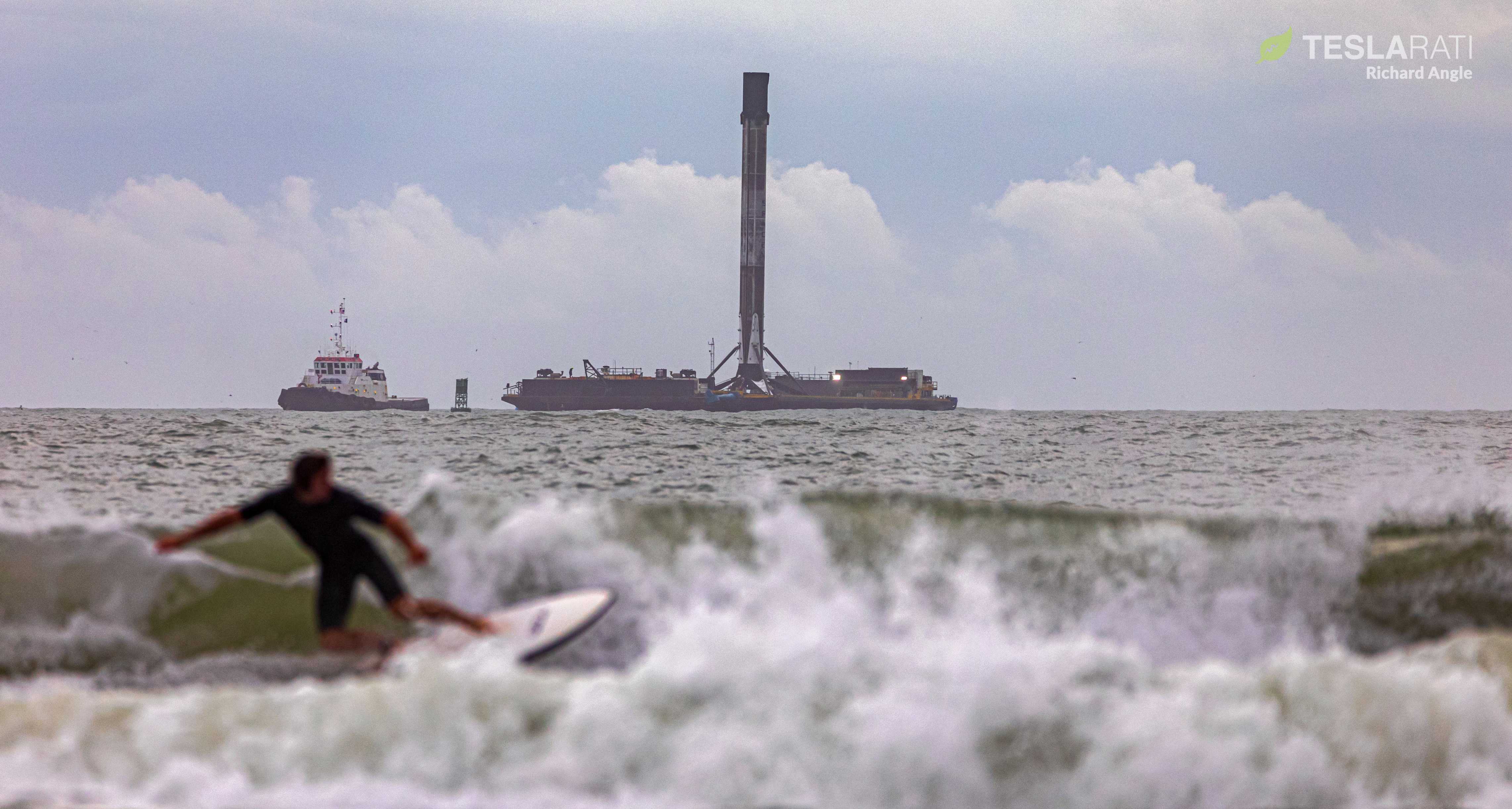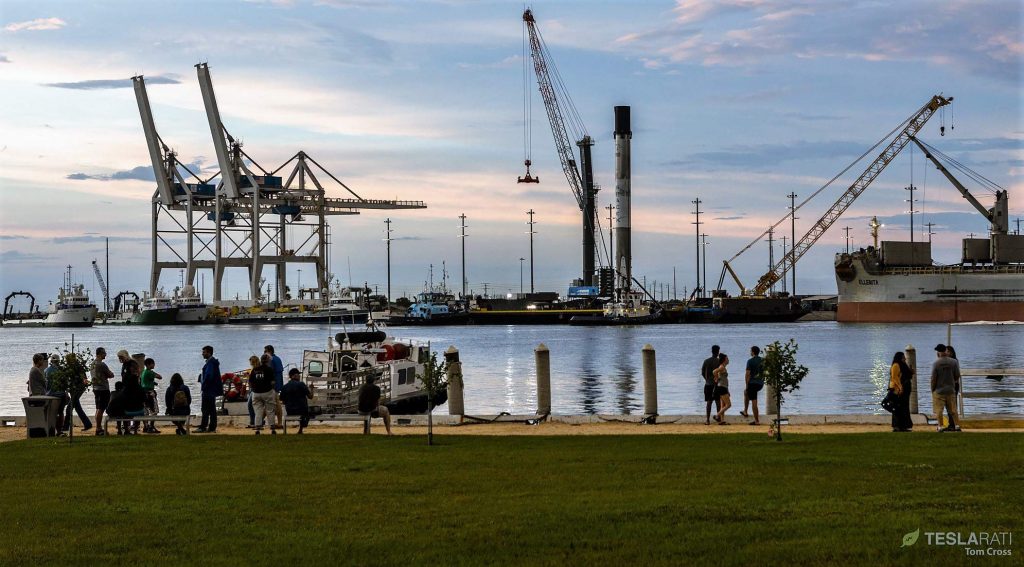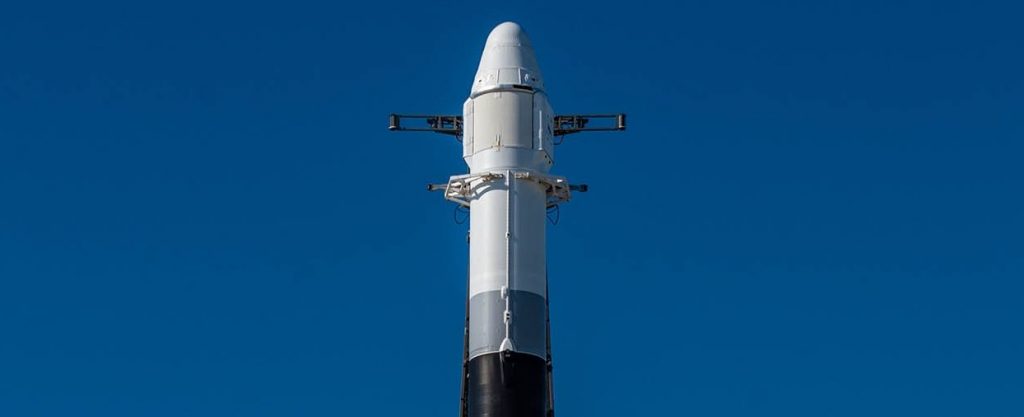

News
SpaceX Falcon 9 launch and landing imminent as drone ship heads to sea
SpaceX’s next Falcon 9 launch and landing is well into the late stages of preparation, leaving the company approximately 24-48 hours away from its next mission to orbit. To support the surprise ocean landing, a drone ship has already been dispatched and recently departed Port Canaveral.
After a frenetic week of preparation, tugboat Hawk departed with drone ship Of Course I Still Love You (OCISLY) on December 1st, preparing for its second recovery attempt in roughly three weeks and SpaceX’s second drone ship landing after a rare, six-month rocket landing lull. In the days leading up to the anticipated departure, workers could be seen performing a routine procedure often nicknamed a “FOD-walk” in which a given surface is scoured for Foreign Object Debris (FOD). This is most commonly performed on runways (including aircraft carriers) and attempts to mitigate or fully prevent damage from rocks and other small debris.
In the case of Falcon booster landings, the rocket’s Merlin 1D engine exhaust velocity is just shy of 3000 m/s (6700 mph), meaning that a tiny rock or leftover rocket piece could almost immediately become a high-subsonic or supersonic projectile in the seconds before touchdown. The drone ship itself is most at risk, but those theoretical projectiles could potentially bank off the platform’s exhaust shields and hit the booster itself, causing far costlier damage.
And hence the FOD-walk pictured above. Once complete, OCISLY was cleared for departure and has since made it about 75% of the way to its planned landing zone coordinates. SpaceX is currently scheduled to launch Cargo Dragon resupply mission CRS-19 on a Falcon 9 rocket no earlier than 12:51 pm EST (16:51 UTC) on December 4th, although a specific weather condition may delay the instantaneous window by 24 hours. Hawk and OCISLY should thus arrive on station one or two days before launch.
As it turns out, this Falcon 9 landing is a bit of mystery: it’s unclear why exactly SpaceX has decided to land the booster at sea instead of the usual Landing Zone recoveries that have followed most recent Cargo Dragon launches. Typically, the low insertion orbit (~200 km x ~390 km) and relatively low mass of Cargo Dragon (less than 10 tons or 22,000 lb) means that Falcon 9 has (literally) tons of propellant left over, giving it the margins needed to flip around, cancel out a huge amount of horizontal velocity, and boost 100+ km (62+ mi) back to shore.
Instead, new Falcon 9 booster B1058 is scheduled to land aboard drone ship OCISLY some 350 km (220 mi) downrange, an unusual distance. For reference, SpaceX’s May 2019 CRS-17 mission is the only time Falcon 9 has landed at sea after a CRS launch since CRS-8, the rocket’s first successful drone ship recovery. That scenario was forced because LZ-1/2 had coincidently been showered in Crew Dragon debris after C201 exploded during testing. Even then, OCISLY was stationed just 20 or so kilometers offshore, meaning that Falcon 9 B1056 still performed a routine Return To Launch Site (RTLS) landing in spirit.

In short, the ~350-km-downrange landing plan suggests that this Cargo Dragon launch may have a much smaller propellant margin than essentially every similar mission preceding it. This could be explained in a few ways. Maybe after Falcon 9 B1050’s surprise landing failure, SpaceX decided that all new Falcon 9 boosters will attempt drone ship landings after their first flight, minimizing the risk to Cape Canaveral in the event of a CRS-16 repeat. Another possibility, Crew Dragon capsule C205 – scheduled to support the spacecraft’s In-Flight Abort (IFA) test late this month or early next – may still be close to the Cape’s Landing Zones, another reason to avoid even the slightest chance of a catastrophic Falcon landing failure.

Finally, it’s also possible that CRS-19 will follow in the footsteps of CRS-18, which sported a prototype Falcon 9 upper stage designed to push the enveloped of its orbital longevity. Falcon 9 B1056 still managed to land at LZ-1 after CRS-18, but a more ambitious follow-on test could potentially require much more propellant, accounting for the drone ship’s position further downrange. With any luck, we’ll find out more later today during SpaceX, NASA, and the US Air Force’s routine pre-launch press conference – stay tuned!
Check out Teslarati’s Marketplace! We offer Tesla accessories, including for the Tesla Cybertruck and Tesla Model 3.
News
These Tesla, X, and xAI engineers were just poached by OpenAI
The news is the latest in an ongoing feud between Elon Musk and the Sam Altman-run firm OpenAI.

OpenAI, the xAI competitor for which Elon Musk previously served as a boardmember and helped to co-found, has reportedly poached high-level engineers from Tesla, along with others from xAI, X, and still others.
On Tuesday, Wired reported that OpenAI hired four high-level engineers from Tesla, xAI, and X, as seen in an internal Slack message sent by co-founder Greg Brockman. The engineers include Tesla Vice President of Software Engineering David Lau, X and xAI’s head of infrastructure engineering Uday Ruddarraju, and fellow xAI infrastructure engineer Mike Dalton. The hiring spree also included Angela Fan, an AI researcher from Meta.
“We’re excited to welcome these new members to our scaling team,” said Hannah Wong, an OpenAI spokesperson. “Our approach is to continue building and bringing together world-class infrastructure, research, and product teams to accelerate our mission and deliver the benefits of AI to hundreds of millions of people.”
Lau has been in his position as Tesla’s VP of Software Engineering since 2017, after previously working for the company’s firmware, platforms, and system integration divisions.
“It has become incredibly clear to me that accelerating progress towards safe, well-aligned artificial general intelligence is the most rewarding mission I could imagine for the next chapter of my career,” Lau said in a statement to Wired.
🚨Optimistic projections point to xAI possibly attaining profitability by 2027, according to Bloomberg's sources.
If accurate, this would be quite a feat for xAI. OpenAI, its biggest rival, is still looking at 2029 as the year it could become cash flow positive.💰 https://t.co/pE5Z9daez8
— TESLARATI (@Teslarati) June 18, 2025
READ MORE ON OPENAI: Elon Musk’s OpenAI lawsuit clears hurdle as trial looms
At xAI, Ruddarraju and Dalton both played a large role in developing the Colossus supercomputer, which is comprised of over 200,000 GPUs. One of the major ongoing projects at OpenAI is the company’s Stargate program,
“Infrastructure is where research meets reality, and OpenAI has already demonstrated this successfully,” Ruddarraju told Wired in another statement. “Stargate, in particular, is an infrastructure moonshot that perfectly matches the ambitious, systems-level challenges I love taking on.”
Elon Musk is currently in the process of suing OpenAI for shifting toward a for-profit model, as well as for accepting an investment of billions of dollars from Microsoft. OpenAI retaliated with a counterlawsuit, in which it alleges that Musk is interfering with the company’s business and engaging in unfair competition practices.
Elon Musk confirms Grok 4 launch on July 9 with livestream event
News
SpaceX share sale expected to back $400 billion valuation
The new SpaceX valuation would represent yet another record-high as far as privately-held companies in the U.S. go.

A new report this week suggests that Elon Musk-led rocket company SpaceX is considering an insider share sale that would value the company at $400 billion.
SpaceX is set to launch a primary fundraising round and sell a small number of new shares to investors, according to the report from Bloomberg, which cited people familiar with the matter who asked to remain anonymous due to the information not yet being public. Additionally, the company would sell shares from employees and early investors in a follow-up round, while the primary round would determine the price for the secondary round.
The valuation would represent the largest in history from a privately-owned company in the U.S., surpassing SpaceX’s previous record of $350 billion after a share buyback in December. Rivaling company valuations include ByteDance, the parent company of TikTok, as well as OpenAI.
Bloomberg went on to say that a SpaceX representative didn’t respond to a request for comment at the time of publishing. The publication also notes that the details of such a deal could still change, especially depending on interest from the insider sellers and share buyers.
Axiom’s Ax-4 astronauts arriving to the ISS! https://t.co/WQtTODaYfj
— TESLARATI (@Teslarati) June 26, 2025
READ MORE ON SPACEX: SpaceX to decommission Dragon spacecraft in response to Pres. Trump war of words with Elon Musk
SpaceX’s valuation comes from a few different key factors, especially including the continued expansion of the company’s Starlink satellite internet company. According to the report, Starlink accounts for over half of the company’s yearly revenue. Meanwhile, the company produced its 10 millionth Starlink kit last month.
The company also continues to develop its Starship reusable rocket program, despite the company experiencing an explosion of the rocket on the test stand in Texas last month.
The company has also launched payloads for a number of companies and government contracts. In recent weeks, SpaceX launched Axiom’s Ax-4 mission, sending four astronauts to the International Space Station (ISS) for a 14-day stay to work on around 60 scientific experiments. The mission was launched using the SpaceX Falcon 9 rocket and a new Crew Dragon capsule, while the research is expected to span a range of fields including biology, material and physical sciences, and demonstrations of specialized technology.
News
Tesla Giga Texas continues to pile up with Cybercab castings
Tesla sure is gathering a lot of Cybercab components around the Giga Texas complex.

Tesla may be extremely tight-lipped about the new affordable models that it was expected to start producing in the first half of the year, but the company sure is gathering a lot of Cybercab castings around the Giga Texas complex. This is, at least, as per recent images taken of the facility.
Cybercab castings galore
As per longtime drone operator Joe Tegtmeyer, who has been chronicling the developments around the Giga Texas complex for several years now, the electric vehicle maker seems to be gathering hundreds of Cybercab castings around the factory.
Based on observations from industry watchers, the drone operator appears to have captured images of about 180 front and 180 rear Cybercab castings in his recent photos.
Considering the number of castings that were spotted around Giga Texas, it would appear that Tesla may indeed be preparing for the vehicle’s start of trial production sometime later this year. Interestingly enough, large numbers of Cybercab castings have been spotted around the Giga Texas complex in the past few months.
Cybercab production
The Cybercab is expected to be Tesla’s first vehicle that will adopt the company’s “unboxed” process. As per Tesla’s previous update letters, volume production of the Cybercab should start in 2026. So far, prototypes of the Cybercab have been spotted testing around Giga Texas, and expectations are high that the vehicle’s initial trial production should start this year.
With the start of Tesla’s dedicated Robotaxi service around Austin, it might only be a matter of time before the Cybercab starts being tested on public roads as well. When this happens, it would be very difficult to deny the fact that Tesla really does have a safe, working autonomous driving system, and it has the perfect vehicle for it, too.
-

 Elon Musk1 week ago
Elon Musk1 week agoTesla investors will be shocked by Jim Cramer’s latest assessment
-

 News2 weeks ago
News2 weeks agoTesla Robotaxi’s biggest challenge seems to be this one thing
-

 Elon Musk1 day ago
Elon Musk1 day agoElon Musk confirms Grok 4 launch on July 9 with livestream event
-

 News2 weeks ago
News2 weeks agoWatch the first true Tesla Robotaxi intervention by safety monitor
-

 News5 days ago
News5 days agoTesla Model 3 ranks as the safest new car in Europe for 2025, per Euro NCAP tests
-

 Elon Musk2 weeks ago
Elon Musk2 weeks agoA Tesla just delivered itself to a customer autonomously, Elon Musk confirms
-

 Elon Musk2 weeks ago
Elon Musk2 weeks agoxAI welcomes Memphis pollution results, environmental groups push back
-

 Elon Musk2 weeks ago
Elon Musk2 weeks agoElon Musk confirms Tesla Optimus V3 already uses Grok voice AI



















